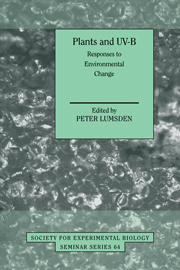Book contents
- Frontmatter
- Contents
- List of contributors
- Preface
- PART I The ozone layer and UV-B radiation
- PART II Effects of UV-B on plants at the cellular level
- DNA damage and repair in plants
- Genetic analysis of DNA repair in plants
- Photosynthesis and photoinhibition
- UV-B effects on the expression of genes encoding proteins involved in photosynthesis
- UV-B perception and signal transduction
- Ultraviolet radiation as a stress factor and the role of protective pigments
- PART III Effects of UV-B at the whole plant and community level
- Index
DNA damage and repair in plants
Published online by Cambridge University Press: 04 August 2010
- Frontmatter
- Contents
- List of contributors
- Preface
- PART I The ozone layer and UV-B radiation
- PART II Effects of UV-B on plants at the cellular level
- DNA damage and repair in plants
- Genetic analysis of DNA repair in plants
- Photosynthesis and photoinhibition
- UV-B effects on the expression of genes encoding proteins involved in photosynthesis
- UV-B perception and signal transduction
- Ultraviolet radiation as a stress factor and the role of protective pigments
- PART III Effects of UV-B at the whole plant and community level
- Index
Summary
Introduction
DNA is a highly reactive molecule that is sensitive to damage from a wide range of both physical and chemical agents. Lesions alter the structure of DNA and consequently interfere with critical aspects of DNA metabolism such as transcription, replication and recombination. The maintenance of genetic integrity is essential for cellular survival, but the eukaryotic genome constantly incurs modifications which are potentially cytotoxic or mutagenic. Such changes can result from cellular exposure to genotoxic compounds present in the environment and from normal products of cellular metabolism. An additional source of genome modifications, particularly relevant to organisms exposed to chronically high levels of natural sunlight, is the ultra-violet radiation contained within this polychromatic light source. UV-B (280–320 nm) is considered to be the most biologically effective radiation within sunlight, although longer wavelengths (UV-A, 320–390 nm, and visible light radiation) do play their part in lesion formation but to a lesser degree (Tyrrell, 1993). (More damaging UV-C radiation is screened by the atmosphere and does not penetrate to the earth's surface.)
DNA is considered to be the primary absorbing chromophore in the cell in the UV-B region of the spectrum. The peak absorption of DNA is dictated by its component nucleotides and occurs at around 260 nm, and there is a sharp drop in photons absorbed by DNA through the UV-B range and any absorbance at wavelengths greater than 320 nm is minimal (Davies, 1995).
- Type
- Chapter
- Information
- Plants and UV-BResponses to Environmental Change, pp. 53 - 76Publisher: Cambridge University PressPrint publication year: 1997
- 19
- Cited by



